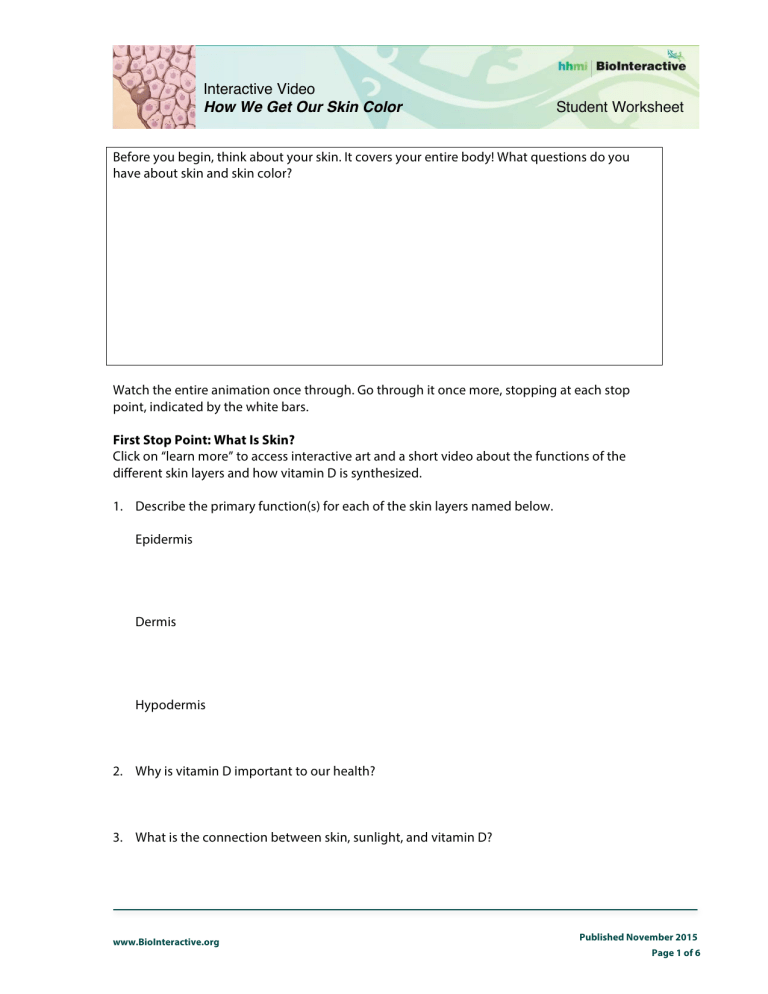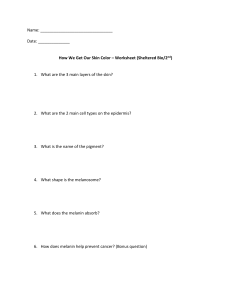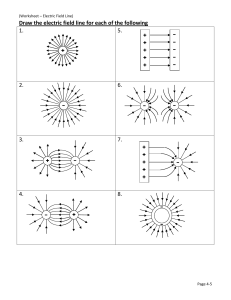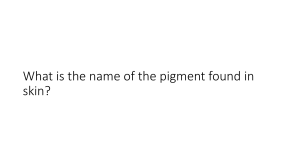
Interactive Video How We Get Our Skin Color Student Worksheet Before you begin, think about your skin. It covers your entire body! What questions do you have about skin and skin color? Watch the entire animation once through. Go through it once more, stopping at each stop point, indicated by the white bars. First Stop Point: What Is Skin? Click on “learn more” to access interactive art and a short video about the functions of the different skin layers and how vitamin D is synthesized. 1. Describe the primary function(s) for each of the skin layers named below. Epidermis Dermis Hypodermis 2. Why is vitamin D important to our health? 3. What is the connection between skin, sunlight, and vitamin D? www.BioInteractive.org Published November 2015 Page 1 of 6 Interactive Video How We Get Our Skin Color Student Worksheet 4. You are a pediatrician and have determined that a young patient is at risk for rickets. Outline a treatment you would recommend to the child’s parents and why you recommend that course of action. Second Stop Point: What Are Skin Cells? Go to the second stop point in the animation to learn about the types of skin cells in the epidermis and why humans lost their hair. 5. What gives keratinocytes their name? 6. Describe the life cycle of a keratinocyte. Where are the youngest keratinocytes in your skin found? The oldest? 7. What is the function of the layer of dead keratinocytes on the top of the epidermis? 8. What is the function of melanocytes? 9. How does a melanocyte’s shape relate to its function? 10. a. When did our human ancestors become mostly hairless? b. What advantage did sweat glands and less body hair provide in our ancestors’ environment? www.BioInteractive.org Published November 2015 Page 2 of 6 Interactive Video How We Get Our Skin Color Student Worksheet Third Stop Point: What Is Melanin? Move to the third stop point to learn about how melanin is made inside melanocytes and one of the genes that controls skin color. 11. Fill in the blanks. Melanin is a ___________________________ that is produced in organelles called _____________________________ in specialized cells called ______________________________. 12. What are the two primary types of melanin and how do they differ? 13. Explain how the amount of eumelanin and number of melanosomes differ between a person with lighter color skin and a person with darker color skin. 14. Which type of melanin is produced by the version of the MC1R gene (i.e., the MC1R allele) most prevalent among people of African ancestry? 15. What can be inferred from the fact that there is little diversity in the form of MC1R gene found among individuals from equatorial Africa? Fourth Stop Point: How Does Melanin Protect Cells? Visit the fourth stop point to learn about how melanin protects DNA from UV damage and how mutations in DNA lead to cancer. 16. a. Name two molecules in the body that UV radiation can damage. www.BioInteractive.org Published November 2015 Page 3 of 6 Interactive Video How We Get Our Skin Color Student Worksheet b. How does melanin protect these molecules from UV damage? 17. What are pyrimidine dimers, what causes them, and why are they dangerous? 18. How can pyrimidine dimers lead to cancer? Fifth Stop Point: How Does Sunlight Cause Tanning? Go to the fifth stop point to learn about the different types of UV radiation and how they affect melanin production. 19. Fill in the blanks. UV radiation has __________________________ wavelengths and _______________________ energy than visible light and infrared radiation. 20. What are the positive and negative effects of UVB exposure? 21. Explain how the relationship between skin color and UV radiation provides evidence that this trait evolved by natural selection. 22. What is the selective pressure for darker skin color? For lighter skin color? www.BioInteractive.org Published November 2015 Page 4 of 6 Interactive Video How We Get Our Skin Color Student Worksheet 23. Explain the difference between constitutive and facultative skin color. 24. What causes skin to tan? What causes skin to sunburn? 25. Your friend, who tans easily, argues that it’s great to get a tan because darker skin pigmentation offers lots more protection from damaging UV radiation, so he’s keeping himself safe. Would you agree? Explain. www.BioInteractive.org Published November 2015 Page 5 of 6 Interactive Video How We Get Our Skin Color Student Worksheet 26. Use arrows to connect the concept bubbles below, making a concept map. Be sure to label your arrows with verbs or linking words, as shown in the example. Skin Skin Color is made up of 3 layers Keratinocytes Melanosomes Epidermis Melanocytes Melanin 7-dehydrocholesterol DNA Vitamin D UV radiation Return to the questions you listed at the beginning. Using the information you learned in this activity, answer any questions you can in the space below. www.BioInteractive.org Published November 2015 Page 6 of 6




